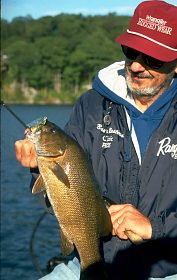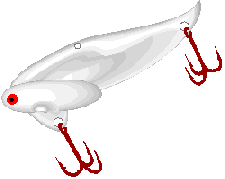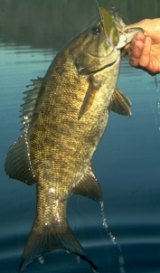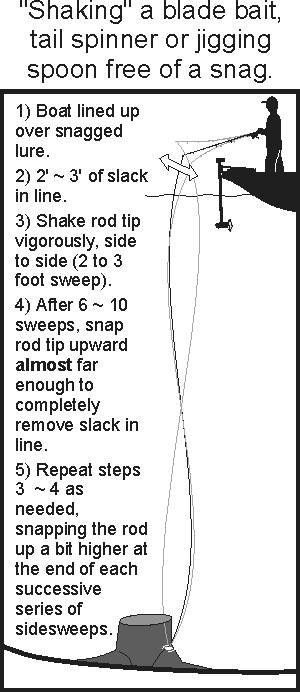When smallmouth bass are using water deeper than 12 to 15 feet, are not around weeds, and are feeding on baitfish, the most effective technique (other than live bait, of course) I've ever found for catching them is blade-baiting the humps. For the past dozen years or more, this technique has accounted for 75% or more of the smallies I've caught from late July through November. catching them is blade-baiting the humps. For the past dozen years or more, this technique has accounted for 75% or more of the smallies I've caught from late July through November.
In lakes where schooling, open water baitfish are available within the smallies' typical depth/water temperature range, they do make heavy use of them. That moves the fish away from the bottom ... and often away from the places that we
(anglers in general)
think of as prime smallmouth water. In many of the waters I fish in the Northeast, despite an abundance of rocky/gravelly bottom structure and loads of crayfish, smallies spend more time eating alewives than crawdads, except in the spring. In other lakes, it might be smelt or shad. Whatever the species of preyfish, if the smallies are relating more to open water finfish rather than bottom oriented crustaceans, the hair jigs and other lures we typically use to imitate crawfish aren't going to be very productive.
Topwater fishing can be good in these lakes, especially at the crack of dawn. But dawn only lasts so long, and I'd rather catch fish all day. Deep diving crankbaits often catch some of fish in this situation, but not nearly consistently enough for my tastes. I suspect that the plugs that are big enough to get into the right depth range are large enough to turn off all but the most aggressive
(or most brain-dead)
smallies. The most consistent answer I've found is the blade bait.
 The typical blade bait consists of a couple treble hooks swinging from a stainless "blade" shaped more-or-less like a fish, with a lead weight molded onto the front/bottom to give it direction and stability. Think of the Heddon Sonar, Silver Buddy, Silver Lucky & Cordell Gay Blade. A few – notably the Reef Runner and Luhr Jensen's Ripple Tail – use a willow leaf spinner blade instead of a flat metal body. Then there's the Bullet, which has the same basic shape as the Sonar and Silver Buddy, but is die cast in one piece, from a zinc alloy. All of them catch fish. In my experience though the ones with the cupped spinner blade for the body generate too much line twist to justify their use, and the less widely available, die cast Bullet, with its harder vibration and slightly slower sink rate, is a valuable option to track down. The typical blade bait consists of a couple treble hooks swinging from a stainless "blade" shaped more-or-less like a fish, with a lead weight molded onto the front/bottom to give it direction and stability. Think of the Heddon Sonar, Silver Buddy, Silver Lucky & Cordell Gay Blade. A few – notably the Reef Runner and Luhr Jensen's Ripple Tail – use a willow leaf spinner blade instead of a flat metal body. Then there's the Bullet, which has the same basic shape as the Sonar and Silver Buddy, but is die cast in one piece, from a zinc alloy. All of them catch fish. In my experience though the ones with the cupped spinner blade for the body generate too much line twist to justify their use, and the less widely available, die cast Bullet, with its harder vibration and slightly slower sink rate, is a valuable option to track down.
The Bullet Bait was the brainchild of Knoxville bass angler, Charlie Nuckols. He sold the company to an Ohio based group, who later renamed it to the Blitz Lure Company.
Charlie Nuckols, the man who created the Bullet and coincidentally popularized "float 'n fly" fishing in East Tennessee, drowned in November, '96, when he slipped into the water while launching his boat to go smallmouth fishing. He was one of the true innovators in the industry, and was unafraid to buck commonly accepted angling wisdom to catch more fish. His brother (Eddie Nuckols) now owns the Bullet Lure company, and you can get Bullets (as well as "float 'n fly" gear) directly from him. Call him at 423-477-2033 for a catalog.
 The secret to successful blade baiting is to work it slowly, and never let the line go slack. From what I've seen, most anglers jump it too hard and too high. Just cast it out on the top of a hard bottomed rise, let it sink on a tight line, and as soon as the line starts to go slack (indicating that the lure has reached bottom) lift the rod tip until you feel the blade thump once or twice. Then just stop lifting and let the lure sink back to the bottom against steady line tension as you simultaneously drop the rod tip back to 2 o'clock and reel just fast enough to maintain contact with the lure.
The secret to successful blade baiting is to work it slowly, and never let the line go slack. From what I've seen, most anglers jump it too hard and too high. Just cast it out on the top of a hard bottomed rise, let it sink on a tight line, and as soon as the line starts to go slack (indicating that the lure has reached bottom) lift the rod tip until you feel the blade thump once or twice. Then just stop lifting and let the lure sink back to the bottom against steady line tension as you simultaneously drop the rod tip back to 2 o'clock and reel just fast enough to maintain contact with the lure.
When anything out of the ordinary happens... the line ticks... the lure feels ‘mushy ’ or heavy... or it just doesn't seem to sink far enough –
SWING!
There's no charge for setting on air.
 If you're sitting
on
the hump or spot, be sure to work the lure all the way back to the boat, and to vertically jig it a few times before winding it up. Often, the change in action turns a follower into a biter. Similarly, If you're sitting
off the structure, once the lure has passed the fish zone and you start to wind it in, stop it dead in its tracks for a 2 count after 4 or 5 turns of the reel handle. Fish that had been mildly interested in the lure bumping along the bottom sometimes chase or follow it when it ‘swims’ away. Killing it after a few feet often forces a reaction. If you're sitting
on
the hump or spot, be sure to work the lure all the way back to the boat, and to vertically jig it a few times before winding it up. Often, the change in action turns a follower into a biter. Similarly, If you're sitting
off the structure, once the lure has passed the fish zone and you start to wind it in, stop it dead in its tracks for a 2 count after 4 or 5 turns of the reel handle. Fish that had been mildly interested in the lure bumping along the bottom sometimes chase or follow it when it ‘swims’ away. Killing it after a few feet often forces a reaction.
Once a certain modicum of rhythm and lure awareness is developed, you can add a swimming, off-bottom retrieve, which is the same technique, at the same cadence, but basing the drop on a count rather than on reaching the bottom, so you end up bringing the bait back anywhere from several feet to a few dozen yards above the bottom instead of bumping it. You still pull the lure with the rod tip rather than the reel, and you still "feel it down" as you wind in the slack from each pull. But you keep it 4 feet to however high you need it above the bottom. I only use this option when I see fish suspended above the structure, and I feel it's a lot harder to master. But it does add a fish to the well often enough to make it worth the effort to learn it.
|